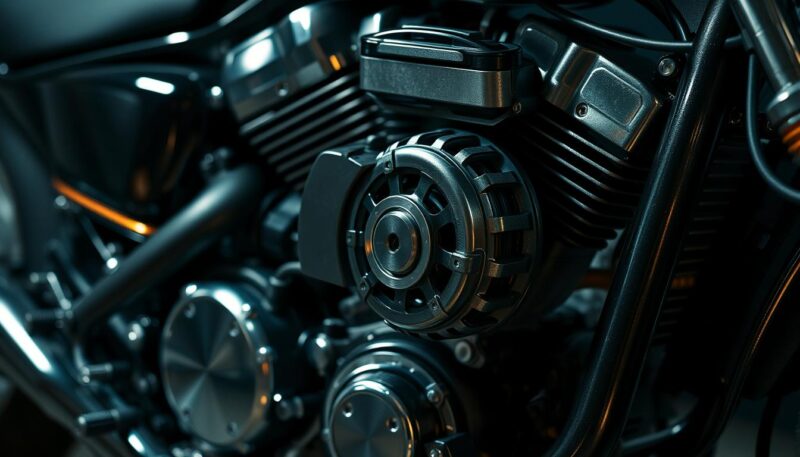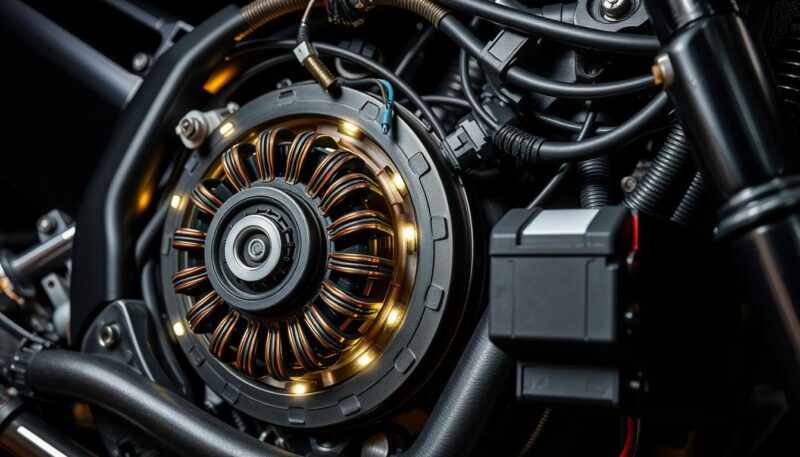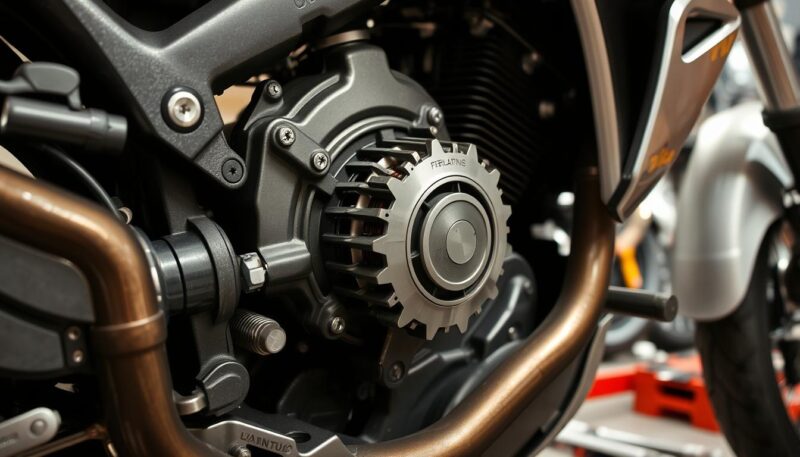As a motorcycle owner or enthusiast, understanding the nuances of your machine’s electrical system is paramount. You might wonder, do motorcycles have alternators? The answer lies in the fascinating world of motorcycle electrical systems, which, while similar to those of cars, feature distinct differences. Most motorcycles do indeed utilize a smaller and less complex version of an alternator known as a stator to generate the electrical power necessary for lighting, ignition systems, and other essential components. This design allows the motorcycle to operate smoothly, despite the size constraints that differentiate it from automobiles.
Motorcycle stators are typically part of the engine assembly, unlike the bulky, externally mounted alternators found in cars. This unique design influences how your motorcycle’s charging system works. In this article, we will delve into the inner workings of motorcycle electrical systems and clarify the role of both alternators and stators in keeping your ride charged and functional. Whether you’re facing battery issues or simply want to enhance your knowledge about your bike, you’ve come to the right place!
Understanding Motorcycle Electrical Systems
The foundation of motorcycle electrical systems lies in their ability to generate and manage electrical power effectively. Understanding how motorcycle power generation works is crucial for both maintenance and performance enhancement. This system begins its process with the mechanical energy produced by the engine, which is transformed into electrical energy through a critical component known as the stator.
The Basics of Electrical Power Generation
In motorcycle power generation, the stator generates alternating current (AC) when the engine runs. This AC is unregulated and must be converted into direct current (DC) to effectively charge the motorcycle’s battery and power its essential electrical components. The proper function of this conversion is vital for the motorcycle’s electrical systems to operate smoothly. Typical output for the stator ranges from 15 to 40 volts, varying by the specific make and model of the motorcycle.
The Role of Voltage Regulators and Rectifiers
Voltage regulators and rectifiers play significant roles in a motorcycle charging system explained. The voltage regulator ensures that the voltage output remains within a safe range of 13.8 to 14.5 volts, preventing potential damage to the battery and other electrical systems. Rectifiers convert the AC produced by the stator into usable DC, enabling the effective operation of all electrical components in the motorcycle. A well-functioning rectifier is essential, as faulty units can lead to battery charging issues and reduced performance.
| Component | Function | Output Range |
|---|---|---|
| Stator | Generates AC from mechanical motion | 15 to 40 Volts |
| Voltage Regulator | Maintains safe voltage levels | 13.8 to 14.5 Volts |
| Rectifier | Converts AC to DC | N/A |
Do Motorcycles Have Alternators?
The inquiry into whether motorcycles have alternators often leads to confusion regarding the terms and mechanisms in use. While typical motorcycles generate electrical power, they primarily rely on stators rather than automotive-style alternators. Understanding this distinction is crucial for grasping how motorcycle electrical systems operate effectively.
What Is an Alternator in Motorcycles?
An alternator in motorcycles refers to any device that transforms mechanical energy into electrical energy. This definition encompasses stators, commonly used in modern motorcycles. The basic functionality involves electromagnetic induction, in which these components generate alternating current. This current is then converted into direct current by regulators and rectifiers to charge batteries and power electrical devices on the motorcycle.
Here’s a breakdown of the types of motorcycle alternators:
| Type | Maximum Power Output (watts) | Efficiency | Reliability | Cost |
|---|---|---|---|---|
| Permanent Magnet | 300-500 | High | Very Reliable | Cheapest |
| Brush-Type | 200-400 | Low | Requires Maintenance | Low Cost |
| Brushless | 500-1,000 | High | More Reliable | Expensive |
Differences Between Alternators and Stators
In the context of motorcycle electrical systems, understanding the difference between alternators and stators is essential for proper diagnosis and maintenance. Most motorcycles utilize a combination of a stator and a rectifier/regulator for power generation. Unlike traditional automotive alternators, the stators in motorcycles generate necessary power internally. Key differences include:
- Stators produce alternating current and rely on rectifiers to convert this into usable direct current.
- Alternators, while similar in function, are often associated with external components, which are less prevalent in motorcycle designs.
- Motorcycle technicians frequently test stators using multimeters to detect starting and charging issues.

How Motorcycles Get Power from Stators
In understanding how motorcycles get power, one must explore the significance of the motorcycle stator. This essential component plays a key role in the motorcycle electrical systems, generating the electrical current necessary to power various functions on the bike.
What Is a Motorcycle Stator?
A motorcycle stator is a collection of wire coils positioned within the engine that work in harmony with a magnetic element. As the engine operates, it rotates the rotor inside the stator, creating a magnetic field. This action generates alternating current (AC) through the principles of electromagnetic induction, which is then converted to direct current (DC) by the motorcycle’s rectifier/regulator.
The Process of Power Generation
During operation, the stator generates power through an efficient process. The rotation of the engine causes the magnetic field to interact with the coils of wire in the stator, inducing an electrical current. This AC is then routed through the regulator/rectifier, transforming it into usable DC power for the motorcycle’s electrical components.
Importance of the Rectifier/Regulator
The rectifier/regulator serves a critical role in the motorcycle charging system explained. Regulating the voltage output helps prevent electrical damage to components. Typically, the output is set to around 14.5V, which is essential for keeping the battery charged and ensuring reliable operation of lights and other electrical systems. A malfunctioning rectifier/regulator can lead to various symptoms, including dimming lights, battery depletion, and poor engine performance.

| Component | Function | Typical Voltage Regulation |
|---|---|---|
| Stator | Generates AC voltage from engine rotation | Varies; dependent on engine speed |
| Rectifier | Converts AC to DC | N/A |
| Regulator | Maintains steady voltage, preventing damage | 14.5V |
Conclusion
In summary, you have learned that the motorcycle charging system is distinct from that of traditional cars. While you might wonder, do motorcycles have alternators? The definitive answer is no; instead, they rely on a combination of stators and rectifiers for efficient power generation. It is crucial to understand how motorcycle electrical systems operate, as they support various essential components, from ignition systems to auxiliary lighting.
Older motorcycle models might utilize a magneto or a DC power generator, but modern machines are typically equipped with a stator that, in conjunction with a rectifier, converts the alternating current produced by the engine into usable direct current. This system is vital for providing power to critical functionalities and ensuring smooth operation of your bike.
Regular maintenance, including inspections by a professional mechanic, is essential to preventing issues within the motorcycle charging system. Malfunctions can manifest through weak sparks or failing electrical components, directly impacting your riding experience. By grasping the intricacies of your bike’s electrical systems—be it recognizing symptoms of a faulty stator or understanding the significance of the rectifier—you can take proactive steps to enhance your motorcycle’s performance and reliability.






